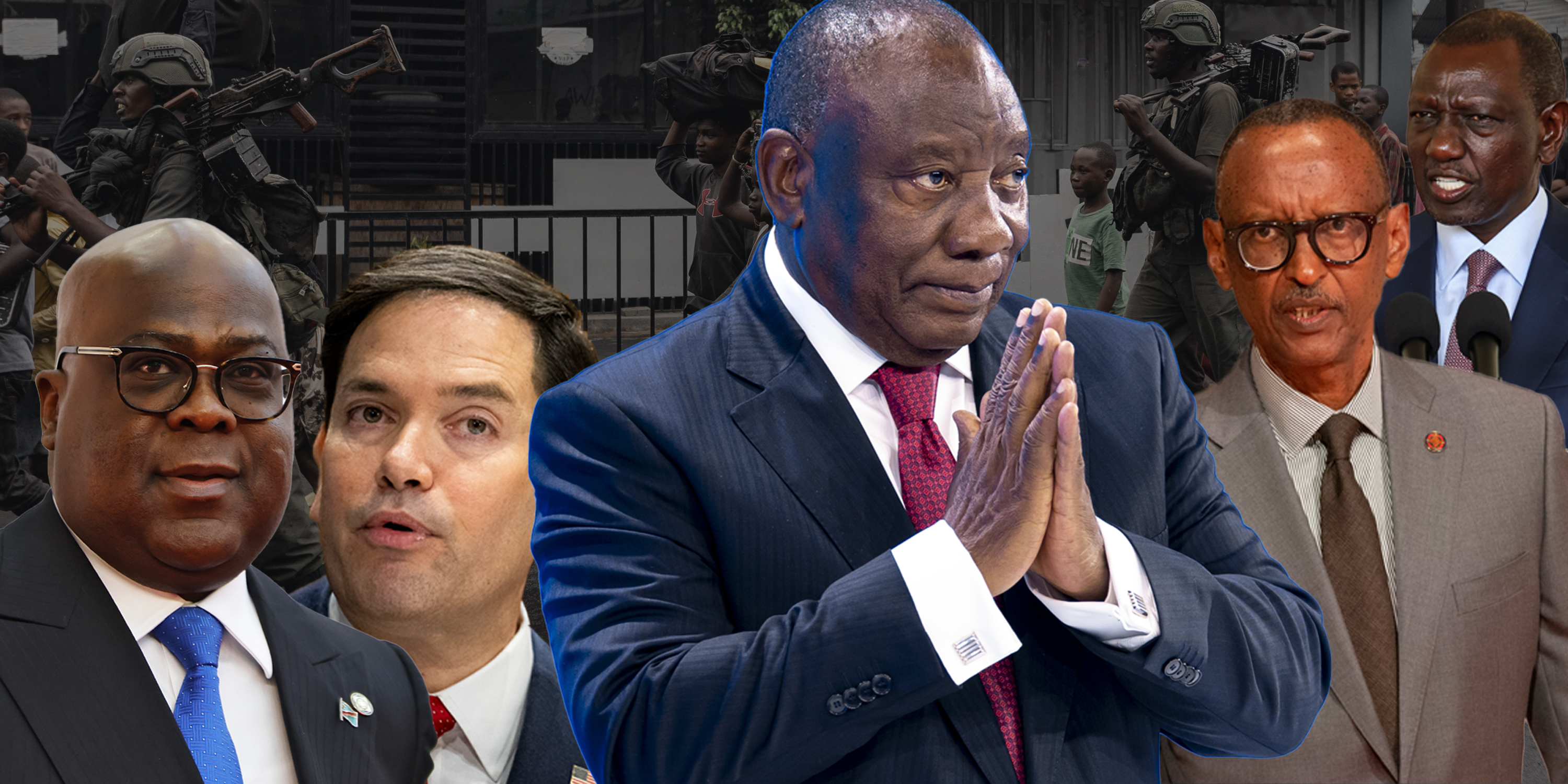Several regional diplomatic initiatives are under way to try to end the major outbreak of war in the eastern Democratic Republic of the Congo (DRC) which has killed 13 South African soldiers and wounded many more over the last week.
President Cyril Ramaphosa called Rwandan President Paul Kagame on Monday evening and the two leaders “agreed on the urgent need for a ceasefire and the resumption of peace talks by all parties to the conflict”, said the SA Presidency in a post on X.
South Africa desperately needs a ceasefire as its troops appear to be trapped by the Rwanda-backed M23 rebels in their two bases in the regional capital of Goma and the nearby town of Sake. Nine SA National Defence Force soldiers were killed when they tried to stop M23 from capturing Goma last week, said the SANDF.
On Monday, 27 January, the SANDF said three more of its soldiers were killed when a mortar fired by M23 at DRC forces landed on the SANDF base near the airport at Goma. One of those injured last week succumbed to his injuries, bringing the death toll to 13. Three Malawian and one Uruguayan soldier also died in the fighting last week.
M23 now appears to be largely in control of Goma, a major prize.
Kenyan President William Ruto has called a summit of the East African Community (EAC) for Wednesday which he hopes will be attended by the two principal leaders involved in the conflict, DRC President Felix Tshisekedi and Kagame. DRC and Rwanda are members of the EAC.
The Southern African Development Community (SADC) on Tuesday night held a virtual summit of the troika of its security organ — Tanzania, Malawi and Zambia — to address the conflict.
SADC deployed the SADC Mission in DRC (SAMIDRC) in December 2023 at the request of Tshisekedi to protect the DRC against Rwanda. The DRC is also a member of SADC. Most of the SANDF soldiers killed over the last few days as well as the three Malawians who died were part of SAMIDRC, though some of the SANDF troops who died were part of the UN peacekeeping mission Monusco.
The UN Security Council held an emergency session in New York on Sunday to discuss the crisis. Monusco head Bintou Keita called on Rwanda to withdraw its forces from Congolese territory and end support for M23, and on the DRC to “make significant efforts” to neutralise the Democratic Liberation Forces of Rwanda (FDLR).
Countering alleged persecution by the FDLR, originally established by Rwandan Hutus who participated in the 1994 genocide largely against Tutsis, is the reason the ethnic-Tutsi M23 gives for its existence — and the reason Rwanda has sometimes given for intervening military in DRC.
The Security Council as a whole strongly condemned the offensive by M23 and demanded the immediate withdrawal of “external forces” from DRC — an implicit reference to Rwanda.
On Tuesday, the African Union’s Peace and Security Council met, virtually, to discuss the crisis. SA’s international relations and cooperation minister, Ronald Lamola, strongly condemned the attacks by the M23.
“We would also like to condemn Rwanda for its support of the M23 as clearly proven by various United Nations reports of experts,” said Lamola. “We therefore call upon Rwanda to cease its support to the M23 and for its forces to withdraw from the DRC. The unauthorised presence of the Rwanda Defence Forces in eastern DRC is in violation of the sovereignty and territorial integrity of the DRC.”
Call for dialogue
Lamola also called for a political dialogue which addressed the concerns of both Rwanda and DRC and for support from the AU and UN for SADC’s mission in DRC.
Top of the agenda of the diplomatic initiatives this week will probably be the Luanda peace process being led by Angolan President João Lourenço. He brokered a ceasefire between DRC and Rwanda in July last year. However, talks for a more permanent peace broke down in December because DRC refused to negotiate with M23, insisting on negotiating with Rwanda as the real force behind M23. Rwanda refused.
Stephanie Wolters, a senior research fellow and Great Lakes expert at the SA Institute of International Affairs, said she hoped Tshisekedi and Kagame would attend the EAC summit on Wednesday and agree to a ceasefire. She thought the US might have been pushing for the summit as it was close to Ruto, who had called for it.
She said dealing with the FDLR issue would be difficult. The Luanda peace process calls for DRC to neutralise the FDLR in exchange for Rwanda withdrawing support for M23. However, neutralising the FDLR will be difficult as it has become so integrated into the community.
Wolters said she hoped that after Lourenço took over as AU chairperson next month he would elevate the DRC issue and broaden it to address greater regional dimensions so it was not just about Rwanda and DRC. Rwanda might then be more inclined to go along with it.
She said Lourenço should involve the AU more substantially in the DRC issue, as it had been “virtually absent on this for the last four years”.
She cautioned that “if there isn't more effective pressure placed on Kagame [to withdraw support from M23], I don’t see how we can really get ourselves out of this.”
She said Ramaphosa had every interest in a ceasefire because SA didn’t want to lose any more lives. “But also Ramaphosa’s political credibility is on the line here a bit, certainly domestically. When he speaks with Kagame, it has to also be about the wider issue, not just ‘Can you please back away from SAMIDRC’.
“I think that’s exactly what Kagame wanted. Kagame wanted to humiliate and intimidate South Africa.”
Kagame, she said, had wanted to capture Goma to use as a bargaining chip in whatever negotiations ensued. DM





